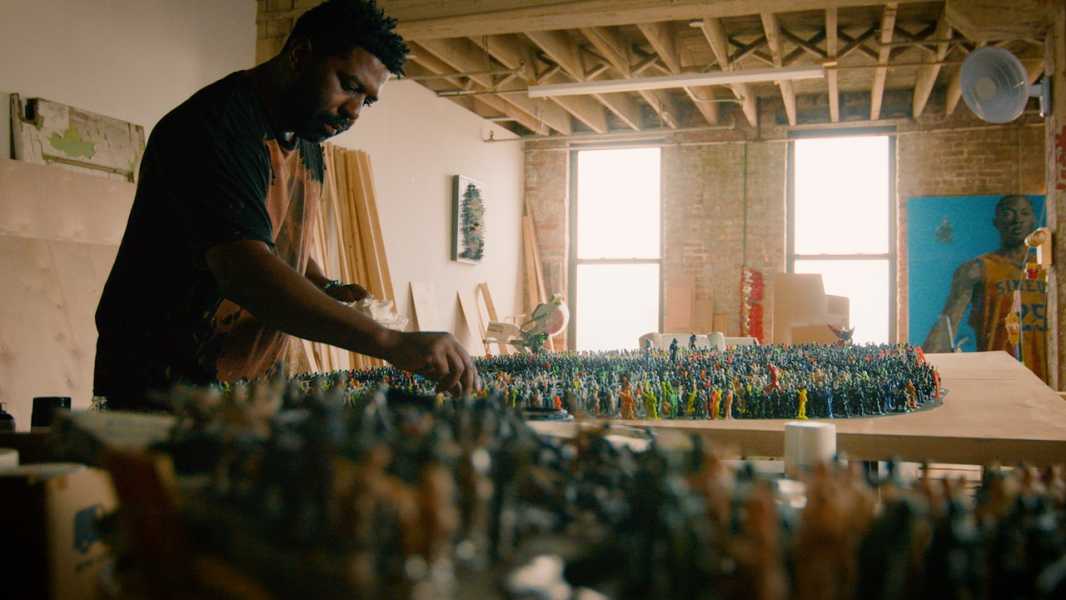
Save this storySave this storySave this storySave this story
Watch Justin Fairweather’s “Roger J. Carter: Rebel Revolutionary.”
One spring day in 2021, Justin Fairweather was driving around Los Angeles and stumbled upon an art exhibit of what appeared to be paintings of Black cultural icons, such as James Baldwin, Fred Hampton, Nina Simone, and Michael Jordan. When he walked in and took a closer look, he realized the pieces were three-dimensional: small toy soldiers dotted the canvases. Most of the toy figurines were soldiers in the conventional sense, meticulously arranged and spray-painted with vibrant colors, some blending into the portraiture underneath, others standing out in neon hues. Some of the miniatures formed circles around more famous action figures: R2-D2, Luke Skywalker, Darth Vader. “I was absolutely blown away by the layers of craftsmanship, and the visual concept of using soldiers standing atop these giant, recognizable figures,” Fairweather said. He couldn’t stop thinking about it. “It hit such a deep nerve. It was like nothing I’ve ever seen before.”
Two months later, Fairweather flew to Chicago to film Roger J. Carter, the artist who made those paintings, and explore the process he uses to create art work that focusses on social injustice. Carter, who grew up in Chicago’s South Side, played basketball in college and wanted to play at the professional level. He later became a software engineer but had always felt like he was born to be an artist. Drawn to the work and legacies of the Black Panther Party and the Black Lives Matter movement, he says in the film that he wanted to tell the stories of revolutionaries—“people who did everything they could to unite the people, even under opposition.” After years of experimentation, he came up with the idea of incorporating soldier figurines into his portraits to represent the concept of power struggles. “There’s always a battle within the piece,” Carter says, in voice-over. “I tell people the soldiers are not really at a fight with each other. They are just standing on the neck of the revolutionary.” He told me the process of creating these pieces is not too different from his older way of making portraits, where he kept adding layers on top of an underpainting. He has always chosen to paint the faces of his subjects in black and white because of how beautiful he thought Black Americans’ monochrome photos looked. “I think the different skin tones, and the depth that we have in our faces, really come out well in black and white,” he said. “And it comes out in any medium. It can be painting, it can be toy soldiers.”
The New Yorker Documentary
View the latest or submit your own film.

The documentary, “Roger J. Carter: Rebel Revolutionary,” has an immersive music-video-like quality that matches Carter’s artistic style. Ahead of filming, Fairweather listened to Carter’s favorite musical artist, J Dilla, which later inspired the rhythm of the film. “I was very much taken by the vibrancy of his work, and I wanted the energy of the film to be an extension of the vibrancy and the bold nature of his work,” he said. The film includes montages of Carter working, layered with upbeat hip-hop music, and slower moments that let viewers take in the beautiful details of the finished art works.
Perhaps the boldest part of the documentary is what Fairweather calls a “heightened surreal sequence,” which illustrates Carter’s artistic journey of landing on toy soldiers. (“Rebel Revolutionary” is Fairweather’s first documentary; having come from the narrative-film world, he wanted to have a “fun, narrative-adjacent” sequence.) Looking a bit frustrated, Carter is drawing on paper as the dimly lit living room spins behind him. The dramatic soundtrack halts, and Carter looks at some stock footage projected on the wall: a tank firing a shell, a kid playing with a toy soldier, and real-life soldiers. “Being an artist myself, I know how much of a struggle it is to come up with something,” Fairweather said. He pitched the scene to Carter and spent months trying to figure out how to construct a spinning rig in Carter’s home. In the end, it was a barber’s chair that Carter possessed, in what Fairweather called “an eclectic collection of things,” that became part of the scene’s equipment.
Fairweather told me the making of the documentary was an incredible collaboration between Carter and him—and that shared artistry comes through while preserving both of their individual styles. It seems fitting that in one of the film’s final scenes we see Carter in a gallery, showcasing his work and conversing with visitors, a mirror of the way he and Fairweather connected in the first place. Carter hopes that the toy soldiers and action figures will help to draw people in when they see his work, so that, even if they may not recognize the faces in the portraits themselves, they step back to take in the whole picture, and ask who these people are. “ ‘Who’s Breonna Taylor?’ And that starts a conversation,” Carter says, in voice-over. “It’s going to shine a light on the war some people fight just by existing.” ♦
Sourse: newyorker.com